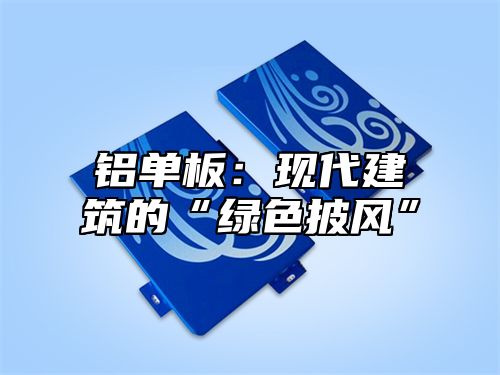

 Industry information
Industry information
Today let's talk about aluminum veneer, a small novelty in the construction industry. You may think it's just an ordinary building material, but in fact, it's an indispensable "green cloak" in modern architecture!
Let's talk about the origin of aluminum veneer. It is a metal sheet mainly made of aluminum or aluminum alloy. This product is not just a name for itself, it is lightweight, durable, and also has some "environmentally friendly" considerations. Imagine the sunlight shining through those aluminum panels and reflecting onto the building, which is both beautiful and energy-efficient. Isn't it instantly taller?
Speaking of aesthetics, aluminum veneer is a versatile guy. It comes in various colors and textures, making it easy to adapt to different architectural styles. If you don't believe me, take a look at those skyscrapers. Which one doesn't have a gorgeous appearance highlighted by aluminum veneer? Like a fashionista, aluminum veneer gives architecture its own 'clothing'.
In addition to appearance, the practical value of aluminum veneer should not be underestimated. Its lightweight design reduces the weight of the building and reduces load-bearing pressure, which is particularly important for high-rise buildings. Aluminum veneer is not easy to rust, corrosion-resistant, has a long service life, and is easy to maintain. Imagine the building downstairs from your house, if it weren't for the aluminum veneer, it would have been covered in rust stains long ago!
However, when it comes to the term 'green cloak', we also need to talk about the environmental properties of aluminum veneer. The production process of aluminum veneer has low energy consumption, which is more in line with the concept of energy conservation and emission reduction compared to other building materials. Aluminum veneer has a high recycling rate, and the recycled aluminum material can be reprocessed to reduce resource waste. Isn't this the legendary concept of sustainable development?
I remember one time, I went to visit a green building project under construction, and aluminum veneers were everywhere on the construction site. I just chatted with a project manager and asked him why he chose this material. He said, "Aluminum veneer is not only beautiful and durable, but also meets the requirements of green buildings. In this way, we have not only created high-quality buildings, but also achieved environmental protection, killing two birds with one stone
The application scenarios of aluminum veneer are quite extensive. We can see it appearing in public buildings such as airports, train stations, shopping malls, as well as high-end residential and office buildings, where aluminum veneer is their "face saving responsibility". Even in some art installations and urban landscapes, aluminum veneers play a unique charm.
Of course, everything has two sides. Aluminum veneer has some issues while being aesthetically pleasing, practical, and environmentally friendly. It may have requirements for welding processes and be difficult to construct. For example, if not handled properly, scratches or fading may occur on the surface of aluminum veneer. When using aluminum veneer, we also need to pay attention to these issues.
Aluminum veneer, known as the 'green cloak', plays an important role in modern architecture. It not only gives the building a magnificent appearance, but also embodies the concepts of environmental protection and energy conservation. Perhaps in the future, aluminum veneer will continue to lead the new trend in the construction industry and become a "fashionable choice" for more buildings.
Speaking of which, what other innovations do you think aluminum veneer will have in the future? Perhaps it will bring more surprises in materials, design, construction, and other aspects. Let's look forward to it together!